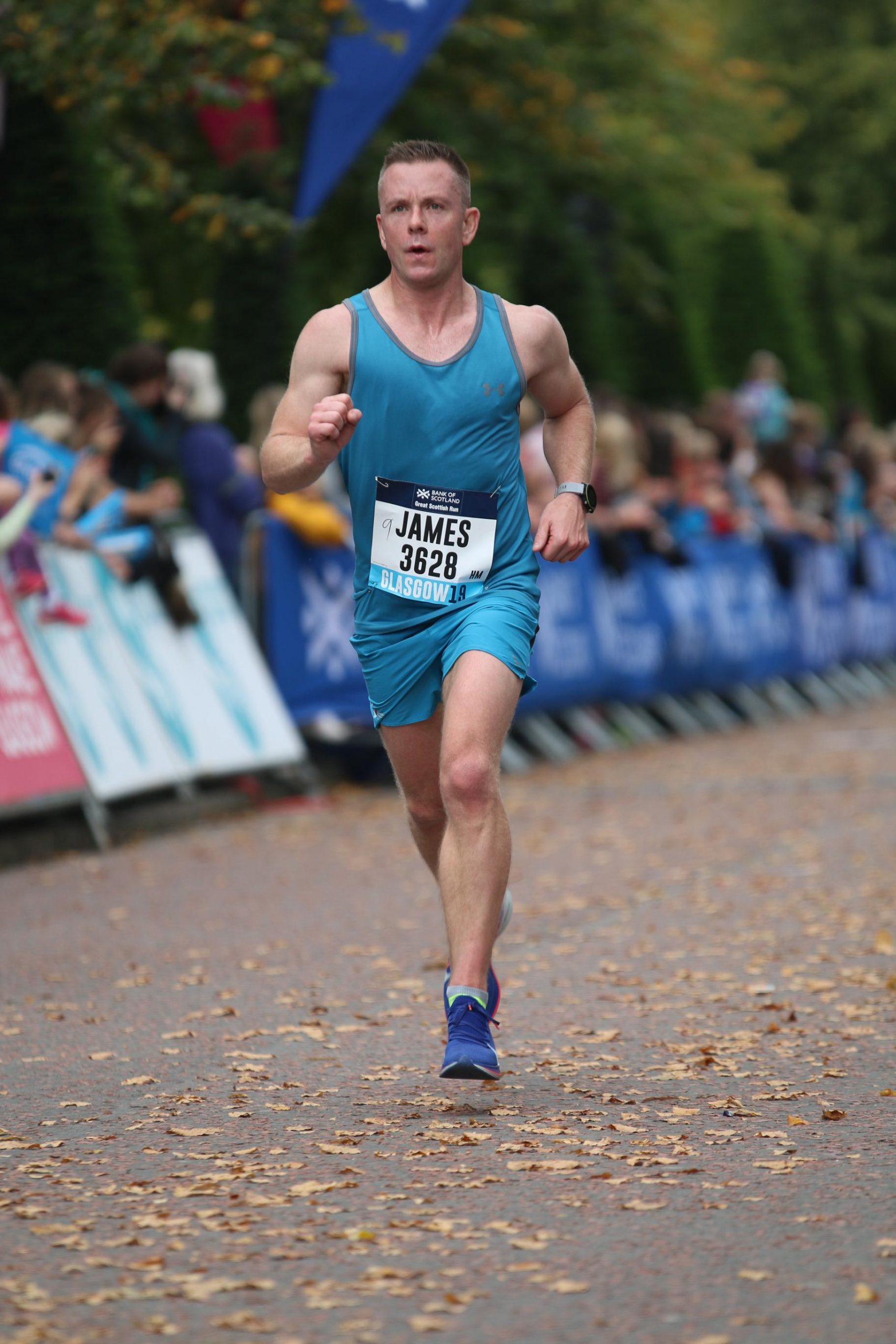I have coached many amateur athletes all of whom are motivated to improve their performance. It does not matter what their event – they want to get faster! That probably does not sound too dissimilar to you.
Most athletes who I coach have a variety of things in common:
- They have busy lives.
- They are dedicated and have a passion for the sport.
- They are very interested in getting faster.
- They want to maximise the effectiveness of their training.
However, when they initially contact me their performances have plateaued, they are experiencing constant niggles and injuries are often recurring. Athletes become frustrated that their hours of dedication are not rewarding them with the performances they dream of, and in many cases are capable of.
WHY DO WE TRAIN?
The reason why people train varies hugely. Being fit and healthy, managing body weight, stress relief from modern life, or completing a bucket list event are all very normal and to be applauded. But most people also have a competitive side and want to test themselves – people want to get faster!
However, from a Sports Science and Strength & Conditioning perspective I am trying to develop your physiology. Every athlete is different with individual physiology and biomechanics. They have different strengths and weaknesses. To keep things really simple, I am trying to help you to train your body’s ability to produce more force, sustain higher forces, all while delaying fatigue in a context specific to your event. Every time your foot strikes the ground when you run you are producing force. Every pull phase during the front crawl or leg kick produces force. With each revolution of the pedal, you are producing force. In simple terms the higher the forces you can produce, and the more force you can sustain for the duration of your event, the faster you have the potential to be. Improving force capacities is the result of well structured and individualised training that develops your energy pathways and biomechanics.
Diagram 1 below shows the improvement of a female athlete that I currently coach. This was over a 5 month period from the time we began working together building up to her first marathon. It all began with testing, establishing a working HRMax, generating accurate training zones and then a Conconi Test to establish the “Threshold”. With 5 months of structured training, you can see how much faster she became over various distances, including a whopping 13:05 minute improvement in the half marathon.
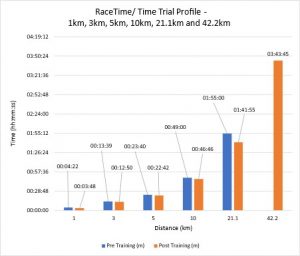
Diagram 1.
5 REASONS YOU NEED TO COMPLETE PERFORMANCE TESTING
- ESTABLISH INDIVIDUAL TRAINING ZONES
With the tech we have readily available we can establish individual training zones for you to use. This can be done for heart rate, power, speed and lactate without the need for expensive laboratories. Elite coach of Tadej Pogacar, Inigo San Millan (2019) is a big supporter using heart rate, but argues a combination of HR, power, speed and lactate may be the best option.
If we take heart rate as an example, 220 – age is a well-known method for measuring maximum heart rate. However, this is a population measure rather than something that works for the individual. To illustrate this, I coach an athlete in his early 30s with a HRMax well over 200bpm. If we predicted a figure in the high 180s as his HRMax, his training zones would be someway out, very possibly having a negative effect on his training and adaptation. By testing we can develop a far more accurate set of training zones, allowing us to individualise training far more precisely.
- EVERY SESSION THEN HAS A PURPOSE
By establishing individual training zones we can then train the athlete’s physiology far more effectively. I am a big fan of Sports Scientist Stephen Seiler’s work. Using his terminology, by establishing individual training zones we can avoid the “training intensity black hole.” This can be thought of as a moderate training intensity that is neither particularly easy or comfortable, but it certainly would not be described as hard. This is without doubt the most common training mistake I see. People go out the door and pick a pace that feels ok on the day, but regularly falls into a moderate intensity that does not develop performance effectively.
As a simple rule most of your training should be relatively easy. Only a small amount of training should be genuinely hard. And for the most part we want to avoid training in between those levels (“the black hole!”). We know that we get great physiological adaptation from training that is quite easy but goes on for longer periods (below 75% of HRMax), and from training that is very challenging (for example training at or above Critical Power or Speed). There may be some value at times training at other intensities, but it should not form the bulk of your training load.
You may have heard about “polarized training” or “80/20” (Diagram 4). Not only does the 80% of relatively low intensity training have significant benefits, but it also means you are fully recovered for the high intensity sessions and can then genuinely push your performance limits.
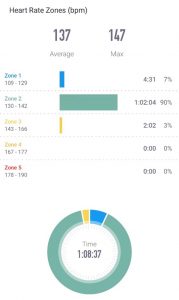
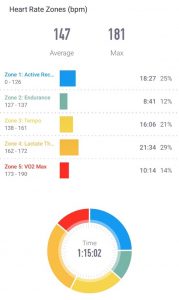
Diagram 2 above shows two HR graphs showing a well conducted zone 2 endurance run on the left with 97% of the time spent in the correct zone, and on the right, you see the graph from a bike session where the same athlete completed 4 x 10 minutes at a threshold power of 230-240 watts. This can be seen in the graph with over 21 minutes in zone 4 and 10 minutes in zone 5. He worked himself hard. Monitoring and prescribing sessions using power and HR is all possible because of the testing process.
3. TESTING HELPS IDENTIFY TRAINING PRIORITIES
Every event has specific demands. A sprint triathlon is completed at much higher intensities than an Ironman and needs training to be tailored to the event. The same can be said of a 5km race and a full marathon on the road. The shorter the event the higher the intensity, and therefore there is an increased need for high intensity training to prepare specifically. A sprint triathlete will need to train a couple of times a week at or above their critical power and speed. Conversely an Ironman triathlete will be operating at significantly lower intensities for prolonged periods of time, and this will be reflected in training prescription in the 10-16 week build up to the race. As a result, the event may determine which tests an athlete decides to use, because they must be relevant to the event they are building up to.
However, once a needs analysis has been carried out the testing process can help us to identify gaps in the individuals performance pipeline. If we can identify that a cyclist has a high maximal power output, but a relatively low critical power or FTP, we can then specifically target this in training, thereby addressing the existing gap and improving performance. If an athlete has relatively low speeds at Zone 2 intensity when preparing for a marathon, we would absolutely look to address this with appropriate training to improve their metabolic efficiency. Testing helps to shape your training!
4. TESTING HELPS PREVENT INJURY
Injury prevention can be a direct or indirect outcome of the testing process. If during a functional movement screen, we see that an athlete has particularly poor mobility around the ankle, this may be an indicator of increased risk of Achilles and knee problems. We therefore make a direct intervention.
Using VALD ForecDecks can help identify muscular imbalances. An athlete may have a significant offset in force production from the left leg to the right. This may be a result of a previous injury or a sign that the repeat use and stress of endurance sport is taking a toll that may lead to injury in the future.
Screening and strength testing are examples of tests that lead to direct interventions to overcome and hopefully prevent future injury.
Similarly, a well-designed training programme plays a significant part in limiting injury risk. I use a polarized training philosophy with the athletes that I coach. I mentioned earlier that the bulk of training should be relatively easy. Not only does this in time significantly improve the metabolic efficiency of the muscle, but it also allows for recovery from the hard training sessions. Done well these sessions cause relatively small amounts of additional muscle breakdown (depending on duration). This allows for recovery from the high intensity training sessions and crucially for adaptation to happen. It also means that you can be as mentally and physically fresh as possible for the next high intensity session, therefore ready to push your limits and develop performance improvement.
A well-designed programme should distribute training intensity effectively to allow for gradual performance improvement and adaptation without adding too much stress that leads to injury. To do this properly, performance testing needs to happen!
As Magness and Stulberg say in their fantastic book, Peak Performance (2017):
Stress + Rest = Growth
Below is Diagram 3 showing you the training volume for an Ironman triathlete over a 30 day period. It includes a short break from training, but you can see they still complete 39 workouts and close to 38 hours of training. With these sorts of volumes tracking intensity is vital to ensure they can cope with the demands, recover from long and hard workouts, and build the volume in all three disciplines so that they can perform in such a grueling event.
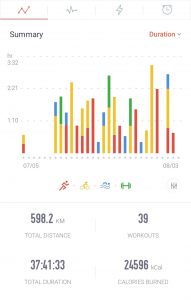
Diagram 3.
And finally Diagram 4 below shows the intensity of the running training completed in the same 30-day block. You will notice that 78% of the total volume is completed in zone 1 and 2. There is a relatively small amount of higher intensity work in zones 4 and 5. You may ask why so much in zone 3 if we are referring to that as the “black hole.” The answer is threefold; firstly this athlete was in a block where we were trying to push performance on the bike. Therefore, there is relatively small amounts of higher intensity seen running (enough to maintain). Secondly, because they are in the specific phase building up to 70.3 and then into an Ironman. As a result, we did spend some time in zone 3 as we experimented with what may become race paces and intensity. And thirdly, because of the lag in heart rate response to reflect intensity – heart has to climb through zone 3 before it registers in zone 4. Again, detailed tracking is only possible because of the testing the athlete completed.
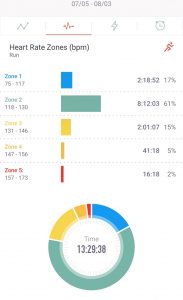
Diagram 4.
5. TESTING = ENJOYMENT
For anyone who has completed any testing you may think that point 5 is crazy. Please stick with me.
Yes, some tests are hard. They can be uncomfortable. But the point of testing is to establish your physiological capabilities so that we can then set training intensities that are relevant to you! So why does testing result in more fun?
Well, if you are anything like me and a good number of the athletes that I coach, we enjoy testing ourselves. I want to know what I can do and how much my performance has improved throughout the training cycle. Seeing the results of our labour is fun. It is motivational!
However, the main thing is very much related to point number 3 and distributing training intensity. In my coaching experience I have found that athletes often find it hard initially to complete easy sessions at a low enough intensity. It is counterintuitive that training at lower intensity is going to help make you faster. However, over time they see quite clearly that it does just that. That is partly because they adapt because of the low intensity training, and partly because they are fresher and ready for the high intensity work. The result is a higher quality training session, more fulfillment, and more results. Training should not feel like a slog from one day to the next. I would challenge anyone who feels like that that they do not have the balance of training right for them. Training should be fun and testing very much supports that!
WHAT NEXT?
I hope this gives you an insight into why performance testing is so important. In my opinion, testing is a crucial part of programming, training prescription and eventually leading to performance improvement.
Depending on your targets and event you should be thinking about testing. Take a look at the “Performance Testing” page on my website for more information. With the technology we have available like GPS watches, turbo trainers, power metres and heart rate monitors it is possible to test remotely if that fits more easily into your lifestyle.
If you have any questions don’t hesitate to get in touch: jimmy@kineticphysio.co.uk
More info can be found here: www.endurancesportperformance.com


